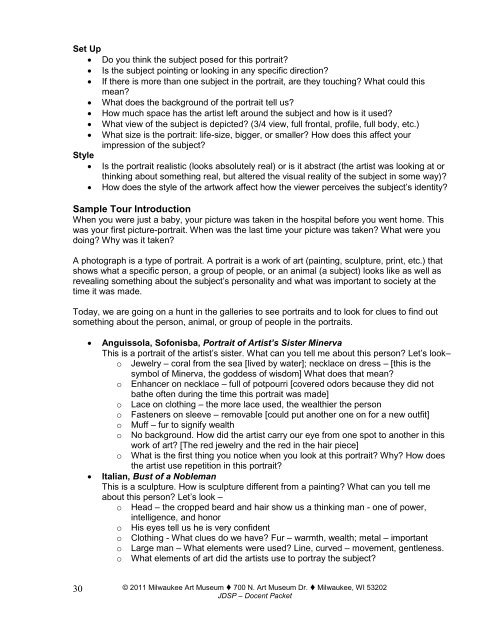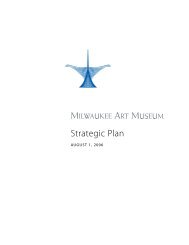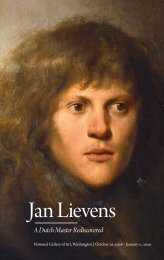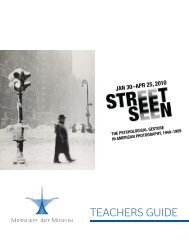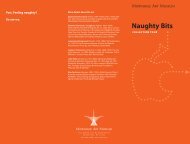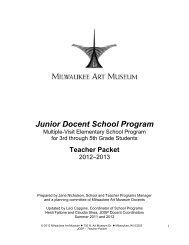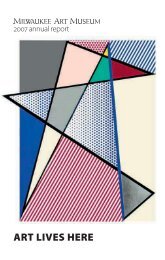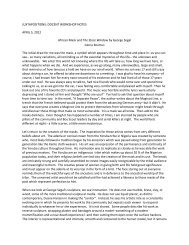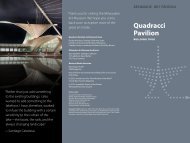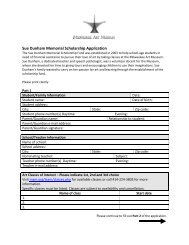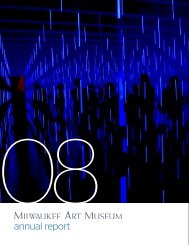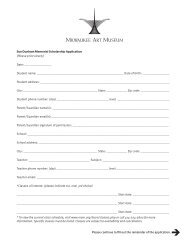Junior Docent School Program - Milwaukee Art Museum
Junior Docent School Program - Milwaukee Art Museum
Junior Docent School Program - Milwaukee Art Museum
Create successful ePaper yourself
Turn your PDF publications into a flip-book with our unique Google optimized e-Paper software.
Set Up<br />
Do you think the subject posed for this portrait?<br />
Is the subject pointing or looking in any specific direction?<br />
If there is more than one subject in the portrait, are they touching? What could this<br />
mean?<br />
What does the background of the portrait tell us?<br />
How much space has the artist left around the subject and how is it used?<br />
What view of the subject is depicted? (3/4 view, full frontal, profile, full body, etc.)<br />
What size is the portrait: life-size, bigger, or smaller? How does this affect your<br />
impression of the subject?<br />
Style<br />
Is the portrait realistic (looks absolutely real) or is it abstract (the artist was looking at or<br />
thinking about something real, but altered the visual reality of the subject in some way)?<br />
How does the style of the artwork affect how the viewer perceives the subject‟s identity?<br />
Sample Tour Introduction<br />
When you were just a baby, your picture was taken in the hospital before you went home. This<br />
was your first picture-portrait. When was the last time your picture was taken? What were you<br />
doing? Why was it taken?<br />
A photograph is a type of portrait. A portrait is a work of art (painting, sculpture, print, etc.) that<br />
shows what a specific person, a group of people, or an animal (a subject) looks like as well as<br />
revealing something about the subject‟s personality and what was important to society at the<br />
time it was made.<br />
Today, we are going on a hunt in the galleries to see portraits and to look for clues to find out<br />
something about the person, animal, or group of people in the portraits.<br />
<br />
<br />
Anguissola, Sofonisba, Portrait of <strong>Art</strong>ist’s Sister Minerva<br />
This is a portrait of the artist‟s sister. What can you tell me about this person? Let‟s look–<br />
o Jewelry – coral from the sea [lived by water]; necklace on dress – [this is the<br />
symbol of Minerva, the goddess of wisdom] What does that mean?<br />
o Enhancer on necklace – full of potpourri [covered odors because they did not<br />
bathe often during the time this portrait was made]<br />
o Lace on clothing – the more lace used, the wealthier the person<br />
o Fasteners on sleeve – removable [could put another one on for a new outfit]<br />
o Muff – fur to signify wealth<br />
o No background. How did the artist carry our eye from one spot to another in this<br />
work of art? [The red jewelry and the red in the hair piece]<br />
o What is the first thing you notice when you look at this portrait? Why? How does<br />
the artist use repetition in this portrait?<br />
Italian, Bust of a Nobleman<br />
This is a sculpture. How is sculpture different from a painting? What can you tell me<br />
about this person? Let‟s look –<br />
o Head – the cropped beard and hair show us a thinking man - one of power,<br />
intelligence, and honor<br />
o His eyes tell us he is very confident<br />
o Clothing - What clues do we have? Fur – warmth, wealth; metal – important<br />
o Large man – What elements were used? Line, curved – movement, gentleness.<br />
o What elements of art did the artists use to portray the subject?<br />
30<br />
© 2011 <strong>Milwaukee</strong> <strong>Art</strong> <strong>Museum</strong> 700 N. <strong>Art</strong> <strong>Museum</strong> Dr. <strong>Milwaukee</strong>, WI 53202<br />
JDSP – <strong>Docent</strong> Packet


